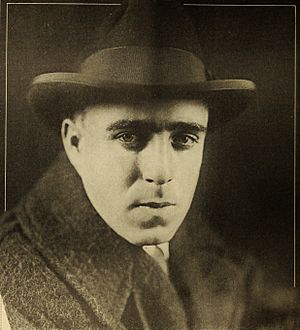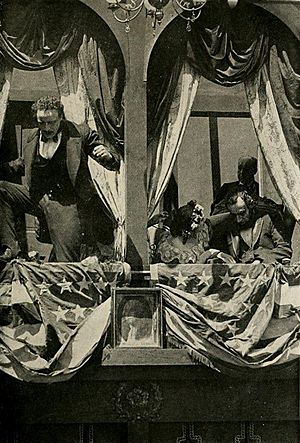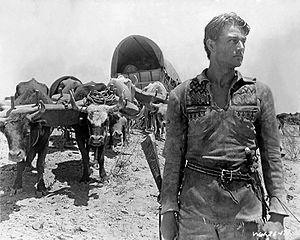Raoul Walsh facts for kids
Quick facts for kids
Raoul Walsh
|
|
|---|---|

Walsh, c. 1918
|
|
| Born |
Albert Edward Walsh
March 11, 1887 New York City, U.S.
|
| Died | December 31, 1980 (aged 93) Simi Valley, California, U.S.
|
| Resting place | Assumption Catholic Cemetery, Simi Valley, Ventura County, California |
| Occupation |
|
| Years active | 1909–1964 |
| Spouse(s) |
Miriam Cooper
(m. 1916; div. 1926)Lorraine Miller
(m. 1928; div. 1947)Mary Simpson
(m. 1947) |
| Relatives | George Walsh (brother) |
| Awards | Founding member of the Academy of Motion Picture Arts and Sciences |
Raoul Walsh (born Albert Edward Walsh; March 11, 1887 – December 31, 1980) was an American film director, actor, founding member of the Academy of Motion Picture Arts and Sciences (AMPAS), and the brother of silent screen actor George Walsh. He was known for portraying John Wilkes Booth in the silent film The Birth of a Nation (1915) and for directing such films as the widescreen epic The Big Trail (1930) starring John Wayne in his first leading role, The Roaring Twenties starring James Cagney and Humphrey Bogart, High Sierra (1941) starring Ida Lupino and Humphrey Bogart, and White Heat (1949) starring James Cagney and Edmond O'Brien. He directed his last film in 1964. His work has been noted as influences on directors such as Rainer Werner Fassbinder, Jack Hill, and Martin Scorsese.
Biography
Walsh was born in New York as Albert Edward Walsh to Elizabeth T. Bruff, the daughter of Irish Catholic immigrants, and Thomas W. Walsh, an Englishman. Walsh was part of Omega Gamma Delta in high school, as was his younger brother. Growing up in New York, Walsh was also a friend of the Barrymore family. John Barrymore recalled spending time reading in the Walsh family library as a youth. Later in life he lived in Palm Springs, California. He was buried at Assumption Cemetery Simi Valley, Ventura County, California.
Film career
Walsh was educated at Seton Hall College. He began acting in 1909, first as a stage actor in New York City and later as a film actor. In 1913 he changed his name to Raoul Walsh. In 1914 he became an assistant to D. W. Griffith and made his first full-length feature film, The Life of General Villa, shot on location in Mexico with Pancho Villa playing the lead, and with actual ongoing battles filmed in progress as well as battle recreations.

Walsh played John Wilkes Booth in Griffith's epic The Birth of a Nation (1915) and also served as an assistant director. This movie was followed by the critically acclaimed Regeneration in 1915, the earliest feature gangster film, shot on location in Manhattan's Bowery district.
Walsh served as an officer in the United States Army during World War I. He later directed The Thief of Bagdad (1924), starring Douglas Fairbanks and Anna May Wong, and Laurence Stallings' What Price Glory? (1926), starring Victor McLaglen and Dolores del Río.

In Sadie Thompson (1928), starring Gloria Swanson, Walsh starred as Swanson's boyfriend in his first acting role since 1915; he also directed the film. He was then hired to direct and star in In Old Arizona, a film about O. Henry's character the Cisco Kid. While on location for that film Walsh was in a car crash when a jackrabbit jumped through the windshield as he was driving through the desert; he lost his right eye as a result. He gave up the part and never acted again. Warner Baxter won an Oscar for the role Walsh was originally slated to play. Walsh would wear an eyepatch for the rest of his life.
In the early days of sound with Fox, Walsh directed the first widescreen spectacle, The Big Trail (1930), an epic wagon train western shot on location, across the West. The movie starred John Wayne, then unknown, whom Walsh discovered as prop man named Marion Morrison, and he was renamed after the Revolutionary War general Mad Anthony Wayne; Walsh happened to be reading a book about him at the time. Walsh directed The Bowery (1933), featuring Wallace Beery, George Raft, Fay Wray and Pert Kelton; the energetic movie recounts the story of Steve Brodie (Raft), supposedly the first man to jump off the Brooklyn Bridge and live to brag about it.
An undistinguished period followed with Paramount Pictures from 1935 to 1939, but Walsh's career rose to new heights after he moved to Warner Brothers, with The Roaring Twenties (1939), featuring James Cagney and Humphrey Bogart; Dark Command (1940), with John Wayne and Roy Rogers (at Republic Pictures); They Drive By Night (1940), with George Raft, Ann Sheridan, Ida Lupino and Bogart; High Sierra (1941), with Lupino and Bogart again; They Died with Their Boots On (1941), with Errol Flynn as Custer; The Strawberry Blonde (1941), with Cagney and Olivia de Havilland; Manpower (1941), with Edward G. Robinson, Marlene Dietrich and George Raft; and White Heat (1949), with Cagney. Walsh's contract at Warners expired in 1953.
He directed several films afterwards, including three with Clark Gable: The Tall Men (1955), The King and Four Queens (1956) and Band of Angels (1957). Walsh retired in 1964. He died of a heart attack in 1980.
Outside interests
Raoul Walsh was a breeder and owner of Thoroughbred racehorses. For a time, his brother George Walsh trained his stable of horses. Their horse Sunset Trail competed in the 1937 Kentucky Derby won by War Admiral who went on to win the U.S. Triple Crown. Sunset Trail finished sixteenth in a field of twenty runners.
Some of Walsh's film-related material and personal papers are contained in the Wesleyan University Cinema Archives.
Selected filmography

- The Pseudo Prodigal (1913 short, director), directorial debut
- The Mystery of the Hindu Image (1914, director) (uncredited)
- The Banker's Daughter (1914)
- The Great Leap; Until Death Do Us Part (1914)
- The Dishonored Medal (1914) – The Adopted Son
- The Life of General Villa (1914) – Villa as a young man
- The Birth of a Nation (1915) – John Wilkes Booth (uncredited)
- Regeneration (1915, director)
- Carmen (1915, director) (with Theda Bara)
- The Outlaw's Revenge (1915) – The outlaw
- Blue Blood and Red (1916, director)
- The Silent Lie (1917, director) (a.k.a. Camille of the Yukon)
- Betrayed (1917, director)
- The Conqueror (1917, director)
- The Innocent Sinner (1917, director)
- The Honor System (1917, director)
- On the Jump (1918, director)
- The Woman and the Law (1918, director)
- The Prussian Cur (1918, director)
- Evangeline (1919, director) (with his wife Miriam Cooper)
- The Strongest (1920, director)
- The Deep Purple (1920, director)
- The Oath (1921, director)
- Kindred of the Dust (1922, director)
- The Thief of Bagdad (1924, director, produced by and starring Douglas Fairbanks, and featuring Anna May Wong)
- The Wanderer (1925, director)
- What Price Glory (1926, director, his most successful silent movie) (with Victor McLaglen and Dolores del Río)
- The Lucky Lady (1926, director)
- The Loves of Carmen (1927, director) (with Dolores del Río)
- The Monkey Talks (1927, director)
- Sadie Thompson (1928, director, also acted alongside Gloria Swanson) – Sergeant Timothy 'Tim' O'Hara (final film role)
- The Red Dance (1928, director) (with Dolores del Río and Charles Farrell)
- Me, Gangster (1928, director, debut of Don Terry)
- The Cock-Eyed World (1929, director)
- The Big Trail (1930, director) (with John Wayne, an early location movie in widescreen and Wayne's first leading role)
- The Man Who Came Back (1931, director) (with Janet Gaynor and Charles Farrell)
- Women of All Nations (1931, director)
- The Yellow Ticket (1931, director) (with Lionel Barrymore and Laurence Olivier)
- Wild Girl (1932, director) (with Charles Farrell, Joan Bennett, Ralph Bellamy, and Eugene Pallette)
- Me and My Gal (1932, director)
- Sailor's Luck (1933, director)
- The Bowery (1933, director) (with Wallace Beery, George Raft, Fay Wray, and Pert Kelton)
- Big Brown Eyes (1936, director) (with Cary Grant and Joan Bennett)
- Klondike Annie (1936, director) (with Mae West and Victor McLaglen)
- O.H.M.S. (1937, director)
- Jump for Glory (1937, director)
- St. Louis Blues (1939, director)
- The Roaring Twenties (1939, director) (with James Cagney and Humphrey Bogart)
- Dark Command (1940, director) (with John Wayne, Roy Rogers, and Gabby Hayes)
- They Drive by Night (1940, director) (with George Raft, Ann Sheridan, Ida Lupino, and Humphrey Bogart)
- High Sierra (1941, director) (with Ida Lupino and Humphrey Bogart)
- The Strawberry Blonde (1941, director) (with James Cagney and Olivia de Havilland)
- They Died with Their Boots On (1941, director) (with Errol Flynn and Olivia de Havilland)
- Manpower (1941, director) (with Edward G. Robinson, Marlene Dietrich, and George Raft)
- Desperate Journey (1942, director) (with Errol Flynn and Ronald Reagan)
- Gentleman Jim (1942, director) (with Errol Flynn and William Frawley)
- Background to Danger (1943, director) (with George Raft, Sydney Greenstreet, Peter Lorre)
- Uncertain Glory (1944, director) (with Errol Flynn)
- Objective, Burma! (1945, director) (with Errol Flynn)
- The Man I Love (1947, director) (with Ida Lupino)
- Pursued (1947, director) (with Robert Mitchum and Teresa Wright)
- Cheyenne (1947, director) (with Dennis Morgan and Jane Wyman)
- Silver River (1948, director) (with Errol Flynn)
- Fighter Squadron (1948, director) (with Edmond O'Brien)
- White Heat (1949, director) (with James Cagney and Edmond O'Brien)
- Colorado Territory (1949, director) (with Joel McCrea, Virginia Mayo, Dorothy Malone, and Henry Hull)
- The Enforcer (1951, director) (with Humphrey Bogart) (uncredited)
- Captain Horatio Hornblower (1951, director) (with Gregory Peck and Virginia Mayo)
- Along the Great Divide (1951, director) (with Kirk Douglas, Virginia Mayo, John Agar and Walter Brennan)
- Distant Drums (1951, director)
- Blackbeard the Pirate (1952, director) (with Robert Newton, Linda Darnell and William Bendix)
- The World in His Arms (1952, director) (with Gregory Peck, Ann Blyth and Anthony Quinn)
- Gun Fury (1953, director) (with Donna Reed and Lee Marvin)
- A Lion Is in the Streets (1953, director) (with James Cagney and Lon Chaney Jr.)
- The Lawless Breed (1953, director) (with Rock Hudson)
- Sea Devils (1953, director) (with Rock Hudson)
- Saskatchewan (1954, director)
- Battle Cry (1955, director)
- The Tall Men (1955, director) (with Clark Gable and Jane Russell)
- The Revolt of Mamie Stover (1956, director) (with Jane Russell and Richard Egan)
- The King and Four Queens (1956, director) (with Clark Gable and Eleanor Parker)
- Band of Angels (1957, director) (with Clark Gable, Yvonne De Carlo, and Sidney Poitier)
- The Sheriff of Fractured Jaw (1958, director)
- Esther and the King (1960, director)
- Marines, Let's Go (1961, director)
- A Distant Trumpet (1964, director) (final film)
Miscellaneous
- The Conqueror (Writer) (1917)
- The Big Trail (story contributor) (uncredited) (1930)
- Captain Horatio Hornblower R.N. (producer) (uncredited) (1951)
- The Lawless Breed (producer) (uncredited) (1953)
- Esther and the King (screenplay) (1960)
- The Men Who Made the Movies: Raoul Walsh (TV movie documentary)
- Himself (1973)
See also
 In Spanish: Raoul Walsh para niños
In Spanish: Raoul Walsh para niños


